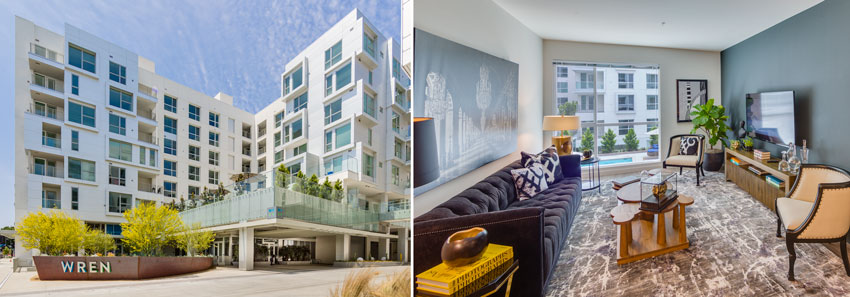Structural Wood Building Systems
Fire and Life Safety
Modern building codes take fire safety and protection seriously. All building materials experience negative impacts from exposure to fire: steel buckles, concrete spalls, and wood burns. Design and engineering analysis, along with supporting research, shows that structurally, wood meets and often surpasses prescriptive building-code requirements for fire, seismic performance, and wind resistance that allow its use in larger buildings. The main difference between the fire resistance of light-frame and mass-timber structural systems is that for mass timber, the fire resistance is inherent in the material (mass of product offers fire resistance), while light-frame systems require active fire-protection measures such as sprinklers, fire watch during construction, firewalls, etc.
North American fire-loss statistics reveal that death and injury in building fires are usually caused by smoke inhalation and occur long before structural failure. When exposed to fire, the outer layers of thick mass-timber members char to provide natural protection against fire penetration. The char layer insulates the wood, slowing combustion and delaying the rate at which heat moves into the layers of wood below. Those areas of the wood not exposed to heat or fire can retain full strength, allowing the member to continue to provide significant structural capacity for the building while it is evacuated. Mass timber’s density means there are no cracks for air or fire to enter, ensuring that the fire’s impact on the wood is gradual and predictable.
Light-frame structural systems, on the other hand, must employ fire-resistance-rated building assemblies to prevent, for a certain period of time, the spread of fire, smoke, and heat from one unit to another (essentially through walls and floors) and ensure that the structural integrity of the building is maintained. Fire resistance-rated walls and floors are also required for exit corridors and stairways to ensure that people can safely leave the building in the event of a fire.
Fire-resistance ratings provide a measure of the time that an assembly will withstand the passage of flame and smoke, and the transmission of heat when exposed to fire under specified fire conditions, including structural loads if applicable. Firewalls are fire separations of noncombustible construction. They have fire-resistance ratings as prescribed in building codes, and structural properties such that they will remain intact under fire conditions for the required fire-rated time. Firewalls are commonly used to divide row-housing blocks into smaller groups and resist the spread of fire from one group to another. They are also used to divide a large building into smaller units where standard fire-protection measures are applicable.
In addition, fire-safety measures must be taken during construction and in occupied buildings. Methods to mitigate the impact of fire on life, safety, and property include:
- Firewalls
- Gypsum encapsulation
- Automatic sprinklers
- Fire detectors and evacuation plans
- Fire-department consultation and approval
The IBC considers fire-impact management and fire-ignition prevention in its guidance on fire resistance. Wood products may be responsible for load-bearing functions, separating functions, or both. As a result, the IBC considers the following factors when determining fire resistance, or how long a component or assembly can continue its function(s) during a fire event:
- Structural resistance: The duration the assembly can support its load during a fire event.
- Integrity: Whether the assembly can prevent the spread of high-heat flames and gases.
- Insulation: Whether the assembly can prevent temperatures on surfaces not directly exposed to flames from rising above its pre-fire temperature by 325 degrees Fahrenheit (180 degrees Celsius) or 250 degrees Fahrenheit (140 degrees Celsius) on average.
Seismic Stability
Earthquakes are another critical concern for design professionals working in some of the most populated regions of the United States, particularly the West Coast. Because seismic events cannot be prevented, buildings in those regions must be designed to maintain structural integrity and keep occupants safe. Recent seismic events as well as research into material performance have given designers and engineers critical insight into how buildings perform under such stress, which is reflected in building codes and project applications.
Research and building-code development have proven that wood components, assemblies, and entire structures are capable of meeting or exceeding the most demanding earthquake and seismic design requirements. Products like CLT, NLT, DLT, glulam, and even light-frame structural systems give designers and engineers a readily available and robust selection of code-approved building materials that can help commercial and residential buildings and other infrastructure better withstand seismic events.
Wood-frame construction offers several characteristics to this end, including:
- Inherently flexibility: Wood’s ability to withstand high loads for short periods of time and retain its elasticity and ultimate strength is an asset in seismic zones.
- Light weight: Wood-frame buildings typically weigh less than those made of concrete and steel, reducing inertial seismic forces, which are proportional to weight, and therefore are more extreme for heavier structures.
- Ductile connections: The ability to yield and displace without fracturing under an earthquake’s abrupt lateral stresses is an attribute of wood-frame construction, which features several nailed connections that allow it to respond to seismic events without critical failure.
- Code compliance: Building codes prescribe minimum fastening requirements for connecting repeated wood-framing members, which is unique to wood-frame construction and benefits its seismic performance.
- Redundant load paths: The numerous fasteners and connectors used in wood-frame construction offer multiple, often redundant, load paths for seismic forces, reducing the chance the structure will collapse if some connections fail.
- Strength and stiffness: The thickness of mass-timber panels and the number and size of nails fastening the assemblies determine each component’s stiffness. Heavy bracing for shear walls can resist lateral distortion common in earthquakes.
The 2015 IBC and the American Society of Civil Engineers/Structural Engineering Institute Minimum Design Loads for Buildings and Other Structures (ASCE 7-10) represent codes and standards for seismic-resistive wood-frame buildings. These standards recognize how structures with ductile detailing, redundancy and regularity deliver high-performance seismic resistance.
Identifying the building risk category is critical to seismic-resistive design. The IBC and ASCE 7-10 group common building types into four levels of risk to human life during a seismic event, from least risk to most risk:
- Risk Category I: agricultural facilities and storage buildings
- Risk Category II: houses, apartment buildings, offices, and stores
- Risk Category III: schools and assembly buildings with occupancy of greater than 300
- Risk Category IV: critical services, including power-generating stations and police and fire stations
Each risk category corresponds to a seismic scale rating (from 1 to 1.5) and allowable drift by story height (from 2.5 percent to 1 percent). The requirements for seismic base shear and drift control in building design are scaled by risk category. The stringent requirements applied to Risk Category IV structures due to their essential nature intends to limit structural and nonstructural damage.
ASCE 7-10 groups wood-frame seismic-force-resisting systems (Table 12.2-1 in ASCE 7-10) accordingly: bearing walls, building frames, and cantilevered columns. Three seismic-force-resisting coefficients are used to gauge the performance of these systems, helping designers and engineers select the right one for their application:
- R factor: response modification coefficient (indicated by R)
- Cd: deflection amplification factor
- Ω0: overstrength factor
The National Design Specification (NDS) for Wood Construction is also helpful when designing wood-frame structures to withstand seismic events. The IBC-referenced design standard covers dimension lumber, glulam, structural composite lumber, and CLT as well as fasteners, connections, and fire design.
Wind Resistance
Seismic events tend to be regional, but buildings everywhere face the risk of damage due to high winds, with each structure reacting differently according to its stiffness, strength and shape. Therefore, all buildings must be designed to safely respond to lateral wind loads. Wood’s elasticity and strength give buildings an advantage during high-wind events.
There are many ways wood can be used to help buildings resist high winds, which can occur along the length and width of the building as well as through vertical uplift. In high-wind events, loads are typically applied in a series of short spurts. Wood is effective at resisting these loads because its elastic limit and ultimate strength are higher when tested for short periods of time.
Wood sheathing in the form of wood structural panels, fiberboard, particleboard, and board sheathing can be used as diaphragms and shear walls that transfer loads delivered by wind events to the building’s foundation. Rigid wood-frame construction, meanwhile, transfers lateral loads in the event of high winds. As with seismic performance, wood-frame construction’s numerous nailed connections give the load more paths to follow, reducing the chance of a structural collapse should some connections fail.
Wind-load requirements are covered under the national code standards but may vary by jurisdiction depending on wind zones. The IBC General Design Requirements for Lateral-Force Resisting Systems (Section 2305) advise on code requirements for wind and lateral-load resistance in buildings using wood shear walls and diaphragms:
- IBC Section 2308 offers guidance on wind and seismic loading for conventional light-frame construction.
- IBC Section 1609 must be considered for shear wall and diaphragm design when wind speeds exceed those allowed in IBC Section 2308. Section 1609 references wind loads established in ASCE 7-10.
- ANSI/AF&PA Special Design Provisions for Wind and Seismic Standard with Commentary (Wind and Seismic) is a referenced standard covering material selection, design, and construction of wood-frame assemblies. It largely follows the IBC, ASCE 7-10, and National Earthquakes Hazard Reduction Program.
Conclusion
We hope we have demonstrated the key differences between light-frame and mass-timber systems, including their applications, code considerations, and performance benefits. Wood structural systems will continue to play an increasingly large role in midrise building design due to its construction efficiency, sustainability, and resiliency over other building systems.
Design Guidance and Resources
There are many resources available to architects and engineers designing mass-timber projects.
- For general information, the Think Wood website offers an expanding library of materials on mass-timber products, research, building examples, and developments related to tall wood buildings.
- The National Design Specification® (NDS®) for Wood Construction is the IBC-referenced design standard for lumber, glulam, SCL, and CLT, including fire design, fasteners, and connections, etc. A mass-timber building in the United States cannot be designed without the NDS.
- The U.S. CLT Handbook includes detailed technical information on the use of CLT. It should be used in conjunction with information provided by manufacturers since most CLT currently available in North America is propriety (i.e., layups aren’t standard across suppliers).
- APA Product Reports signify a product’s compliance with relevant provisions of the model building codes. The L-Series covers products manufactured from lumber, veneer, or other wood base, such as glulam and structural composite lumber (SCL).
For one-on-one support (at no cost), technical experts at WoodWorks are available to provide free project assistance related to nonresidential and multifamily buildings in the United States, including those using mass timber. Designers have the option of contacting an expert in their region www.woodworks.org/projectassistance or emailing help@woodworks.org.










